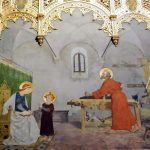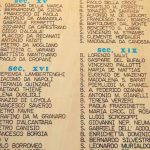150 YEARS OF THE NAZARETH SISTERS
In the footsteps of Blessed Frances Siedliska in Rome (24)
Sr. M. Beata Rudzińska, CSFN

Loreto Sisters
In the already mentioned Diary of Fr. Peter Semenenko, especially in the notes from the first period of his acquaintance with Frances Siedliska, we find many entries in which he calls the congregation founded by her the Loreto Sisters and her house the Loreto House. Only from 1878 does the name begin to appear: the House of Nazareth or the Nazareth House.
Why the Loreto Sisters? Let us give the floor to Mother Siedliska’s postulator and biographer, Fr. Antonio Ricciardi:
“Whoever looks through Mother Siedliska’s diary, those simple and laconic notes written in a notebook or on blank pages of a calendar, will encounter a name that is repeated often: Loreto! And indeed: there was no trip from the north to Rome or from Rome to the north without a stop at Loreto. In Loreto she found her destination. For her, Loreto was Nazareth, the home of the Holy Family, the home that witnessed all virtues, Mary and Joseph’s caring love for Jesus and Christ’s obedience. At first she called the congregation’s mother house Loreto, but later only gave it the name Nazareth. The rationale for the small community’s existence is clearly stated: “to live in hiddenness and to imitate all the virtues of the Holy Family of Nazareth,” as Frances wrote in her request to the Holy Father Pius IX.”
The Holy House (La Santa Casa), which is placed inside the Basilica of Loreto, is the bricked part of Mary of Nazareth’s home. The other part of Her dwelling or Grotto of the Annunciation carved in the rock is in the Basilica of Nazareth. According to ancient tradition, when the Muslims occupied the Holy Land, participants of the Crusades transported the walls of the Nazareth house to Europe. They arrived in what is now Loreto on the night of December 9-10, 1294. A pious tradition says that the house was moved by the Angels themselves. Pius IX simply stated that this happened “by the will of God.”
Archaeological research in Nazareth and Loreto confirms that the two parts of Mary’s house match, with the material and method of construction coming from Palestine. Inscriptions and Christian signs from the first centuries, characteristic or identical to those of the Holy Land or Nazareth itself, have been discovered on 60 stones. Also in the Holy House is the Altar of the Apostles of Palestinian origin, at which, according to tradition, the Apostles celebrated when they stayed in Mary’s house.
Francis’ successor, Mother Laureta – Tekla Lubowidzka, who began her novitiate on December 10, 1883, the day of Our Lady of Loreto’s memorial, purchased a house in Loreto after the Foundress’ death, where the Nazareth Sisters still minister today.
Pictures – Sr. Amata Nowaszewska CSFN
View of the Basilica of Loreto
The Holy House from outside and inside
Plaque with the names of the saints and blessed who made pilgrimages to Loreto
The house and chapel of the Nazareth Sisters in Loreto
The cemetery of Polish soldiers from World War II, which is cared for by the Nazareth Sisters







